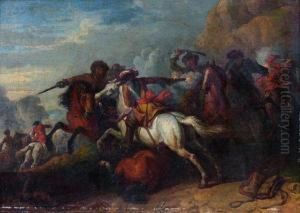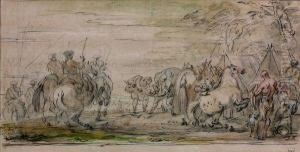Jean Joseph Parrocel Paintings
Jean Joseph Parrocel was a French painter, born in Brignoles, Provence, in 1646. He hailed from a family steeped in the arts, with his grandfather, Barthélemy Parrocel, being recognized for his skill in painting, and his father, Antoine Parrocel, also a painter, who played a crucial role in Jean Joseph's early art education. Parrocel's journey into the realm of art took him beyond the confines of his family's teachings. Seeking to expand his horizons, he moved to Paris, where he became a student of the renowned Charles Le Brun, a pivotal figure in French art during the reign of Louis XIV. Under Le Brun's guidance, Parrocel honed his skills, particularly in the genre of battle scenes, which would later define his career.
Parrocel's work is predominantly characterized by dynamic representations of military engagements and horse battles, genres in which he excelled and for which he gained significant acclaim. His paintings are noted for their vigorous portrayal of action, meticulous attention to detail, and the ability to convey the chaos and fervor of battle. In 1676, his talents were recognized by the French Academy, and he was admitted as a member, an honor that solidified his status as a respected artist of his time.
Beyond his accomplishments in France, Parrocel's reputation as a master of battle scenes earned him international recognition. In 1687, he was invited by the Duke of Savoy to Turin, Italy, where he was commissioned to create works depicting the duke's military victories. This period was marked by prolific output and significant artistic development, with Parrocel embracing the influence of the Italian landscape and light, which added a new dimension to his work.
Jean Joseph Parrocel's legacy extends beyond his contributions to the genre of battle painting. He was also a talented engraver and draughtsman, skills that allowed him to produce a vast oeuvre that included sketches, studies, and prints alongside his paintings. His work was instrumental in popularizing the depiction of military subjects in art, influencing subsequent generations of artists.
Parrocel died in Paris in 1704, leaving behind a body of work that continues to be admired for its vitality, technical skill, and historical significance. His paintings not only serve as masterful artistic expressions but also as valuable historical documents that offer insight into the military conflicts of his era. Through his unique vision and dedication, Jean Joseph Parrocel secured his place in the annals of French art history as one of the foremost painters of battle scenes.

